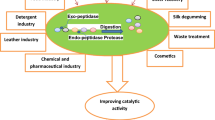Abstract
Baculovirus expression vector system (BEVS) is widely used for production of recombinant eukaryotic proteins in insect larvae or cultured cells. BEVS has advantages over bacterial expression system in producing post-translationally modified secreted proteins. However, for some unknown reason, it is very difficult for insects to secrete sufficiently for certain proteins of interest. To understand the reasons why insect cells fail to secrete some kinds of recombinant proteins, we here employed three mammalian proteins as targets, EPO, HGF, and Wnt3A, with different secretion levels in BEVS and investigated their mRNA transcriptions from the viral genome, subcellular localizations, and interactions with silkworm ER chaperones. Moreover, we observed that no significantly influence on the secretion amounts of all three proteins when depleting or overexpressing most endogenous ER chaperone genes in cultured silkworm cells. However, among all detected ER chaperones, the depletion of BiP severely decreased the recombinant protein secretion in BEVS, indicating the possible central role of Bip in silkworm secretion pathway.






Similar content being viewed by others
References
Suzuki T, Kanaya T, Okazaki H et al (1997) Efficient protein production using a Bombyx mori nuclear polyhedrosis virus lacking the cysteine proteinase gene. J Gen Virol 78:3073–3080
Gómez-Sebastián S, López-Vidal J, Escribano JM (2014) Significant productivity improvement of the baculovirus expression vector system by engineering a novel expression cassette. PLoS One 9:e96562. doi:10.1371/journal.pone.0096562
Hong SM, Yamashita J, Mitsunobu H et al (2010) Efficient soluble protein production on transgenic silkworms expressing cytoplasmic chaperones. Appl Microbiol Biotechnol 87:2147–2156. doi:10.1007/s00253-010-2617-0
Jarvis DL (2003) Developing baculovirus-insect cell expression systems for humanized recombinant glycoprotein production. Virology 310:1–7. doi:10.1016/S0042-6822(03)00120-X
Ellgaard L, Molinari M, Helenius A (1999) Setting the standards: quality control in the secretory pathway. Science 286:1882–1888. doi:10.1126/science.286.5446.1882
Kleizen B, Braakman I (2004) Protein folding and quality control in the endoplasmic reticulum. Curr Opin Cell Biol 16:343–349. doi:10.1016/j.ceb.2004.06.012
Hampton RY (2002) ER-associated degradation in protein quality control and cellular regulation. Curr Opin Cell Biol 14:476–482. doi:10.1016/S0955-0674(02)00358-7
Ruggiano A, Foresti O, Carvalho P (2014) Quality control: ER-associated degradation: protein quality control and beyond. J Cell Biol 204:869–879. doi:10.1083/jcb.201312042
Shen X, Zhang K, Kaufman RJ (2004) The unfolded protein response–a stress signaling pathway of the endoplasmic reticulum. J Chem Neuroanat 28:79–92. doi:10.1016/j.jchemneu.2004.02.006
Schröder M, Kaufman RJ (2005) ER stress and the unfolded protein response. Mutat Res 569:29–63. doi:10.1016/j.mrfmmm.2004.06.056
Cao SS, Kaufman RJ (2012) Unfolded protein response. Curr Biol 22:R622–R626. doi:10.1016/j.cub.2012.07.004
Xu C, Bailly-Maitre B, Reed J (2005) Endoplasmic reticulum stress: cell life and death decisions. J Clin Investig 115:2656–2664. doi:10.1172/JCI26373.2656
Mon H, Li Z, Kobayashi I et al (2013) Soaking RNAi in Bombyx mori BmN4-SID1 cells arrests cell cycle progression. J Insect Sci 13:155. doi:10.1673/031.013.15501
Xu J, Mon H, Kusakabe T et al (2013) Establishment of a soaking RNA interference and Bombyx mori nucleopolyhedrovirus (BmNPV)-hypersensitive cell line using Bme21 cell. Appl Microbiol Biotechnol 97:10435–10444. doi:10.1007/s00253-013-5279-x
Delorme E, Lorenzini T, Giffin J (1992) Role of glycosylation on the secretion and biological activity of erythropoietin. Biochemistry 31:9871–9876
Kobayashi Y, Nakamura N, Ishizaka T et al (2001) Molecular cloning of feline hepatocyte growth factor (HGF) cDNA. J Vet Med Sci 63:211–214
Roelink H, Nusse R (1991) Expression of two members of the Wnt family during mouse development–restricted temporal and spatial patterns in the developing neural tube. Genes Dev 5:381–388. doi:10.1101/gad.5.3.381
Soejima Y, Lee JM, Nagata Y et al (2012) Comparison of signal peptides for efficient protein secretion in the baculovirus-silkworm system. Cent Eur J Biol 8:1–7. doi:10.2478/s11535-012-0112-6
Ono C, Nakatsukasa T, Nishijima Y et al (2007) Construction of the BmNPV T3 bacmid system and Its application to the functional analysis of BmNPV he65. J Insect Biotechnol Sericol 167:161–167
Mon H, Kobayashi I, Ohkubo S et al (2012) Effective RNA interference in cultured silkworm cells mediated by overexpression of Caenorhabditis elegans SID-1. RNA Biol 9:38–44. doi:10.4161/rna.9.1.18084
Li Z, Tatsuke T, Sakashita K et al (2012) Identification and characterization of Polycomb group genes in the silkworm, Bombyx mori. Mol Biol Rep 39:5575–5588. doi:10.1007/s11033-011-1362-5
Li Z, Cheng D, Mon H et al (2013) Cell cycle-dependent recruitment of polycomb proteins to the ASNS promoter counteracts C/ebp-mediated transcriptional activation in Bombyx mori. PLoS One 8:e52320. doi:10.1371/journal.pone.0052320
Imai S, Li Z, Iiyama K, Miyagawa Y (2013) Biologically active human bone morphogenetic protein 4 fused to collagen-binding domain produced in silkworm-baculovirus expression system. J Insect Biotechnol Sericol 44:39–44. doi:10.11416/jibs.82.2_039
Nishikawa S, Brodsky JL, Nakatsukasa K (2005) Roles of molecular chaperones in endoplasmic reticulum (ER) quality control and ER-associated degradation (ERAD). J Biochem 137:551–555. doi:10.1093/jb/mvi068
Takeuchi M, Kobata A (1991) Structures and functional roles of the sugar chains of human erythropoietins. Glycobiology 1:337–346
Nakamura T (1991) Structure and function of growth. Prog Growth Factor Res 3:67–85
MacDonald BT, Hien A, Zhang X et al (2014) Disulfide bond requirements for active wnt ligands. J Biol Chem 289:18122–18136. doi:10.1074/jbc.M114.575027
Hendershot LM, Valentine VA, Lee AS et al (1994) Localization of the gene encoding human BiP/GRP78, the endoplasmic reticulum cognate of the HSP70 family, to chromosome 9q34. Genomics 20:281–284. doi:10.1006/geno.1994.1166
Gething MJ (1999) Role and regulation of the ER chaperone BiP. Semin Cell Dev Biol 10:465–472. doi:10.1006/scdb.1999.0318
Mayer M, Kies U, Kammermeier R, Buchner J (2000) BiP and PDI cooperate in the oxidative folding of antibodies in vitro. J Biol Chem 275:29421–29425. doi:10.1074/jbc.M002655200
Ellgaard L, Frickel E (2003) Calnexin, calreticulin, and ERp57: teammates in glycoprotein folding. Cell Biochem Biophys 39:223–247. doi:10.1385/CBB:39:3:223
Zhang K, Kaufman RJ (2004) Signaling the unfolded protein response from the endoplasmic reticulum. J Biol Chem 279:25935–25938. doi:10.1074/jbc.R400008200
Walter P, Ron D (2006) The unfolded protein response: from stress pathway to homeostatic regulation. Mol Biotechnol 34:279–290. doi:10.1385/MB:34:2:279
Acknowledgments
The cost of publication was supported in part by the Research Grant for Young Investigators of Faculty of Agriculture, Kyushu University.
Author information
Authors and Affiliations
Corresponding author
Ethics declarations
Conflict of interest
None.
Rights and permissions
About this article
Cite this article
Imai, S., Kusakabe, T., Xu, J. et al. Roles of silkworm endoplasmic reticulum chaperones in the secretion of recombinant proteins expressed by baculovirus system. Mol Cell Biochem 409, 255–262 (2015). https://doi.org/10.1007/s11010-015-2529-5
Received:
Accepted:
Published:
Issue Date:
DOI: https://doi.org/10.1007/s11010-015-2529-5




